Study visit to Berlin and Dresden, 23 – 29 April 2016
Our party of twenty-two landed in bitter weather at Berlin’s Tegel airport, through whose efficient reception processes we were quickly whisked onto the coach for our 120-mile drive to Dresden. Even before reaching our hotel, we had stopped to visit Pfunds Molkerei, a magnificently-tiled dairy shop that was our first Buying Opportunity – was this too early in the visit to describe a building as ‘incredible’?
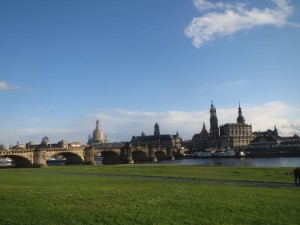 Our hotel was close to the spot where Canaletto’s nephew Bernardo Bellotto sat to paint his famous view of Augustus Bridge and the Dresden skyline. But there was to be no sitting for us; next morning we hit the ground walking, and hardly paused for the next seven hours. The Old Masters Gallery at the Zwinger Palace, the Royal Palace, the celebrated collections of objets d’art in the Green Vaults, the Procession of Princes – only the interior of the Frauenkirche was difficult for us to visit, thwarted as we were by the local practice of holding church services on a Sunday. We were surprised to learn that the sooty appearance of the apparently ancient stonework of many buildings was actually the effect of weathering on the local Saxony sandstone. In fact, many of those blackened stones are quite new; the visitor from abroad – and perhaps especially the British visitor – needs to recall at every turn that most of central Dresden’s superb baroque churches, the palaces, the opera house, the many fine residences that seem to have sat there for several centuries, have been painstakingly reconstructed after the destruction visited on the city in February 1945.
Our hotel was close to the spot where Canaletto’s nephew Bernardo Bellotto sat to paint his famous view of Augustus Bridge and the Dresden skyline. But there was to be no sitting for us; next morning we hit the ground walking, and hardly paused for the next seven hours. The Old Masters Gallery at the Zwinger Palace, the Royal Palace, the celebrated collections of objets d’art in the Green Vaults, the Procession of Princes – only the interior of the Frauenkirche was difficult for us to visit, thwarted as we were by the local practice of holding church services on a Sunday. We were surprised to learn that the sooty appearance of the apparently ancient stonework of many buildings was actually the effect of weathering on the local Saxony sandstone. In fact, many of those blackened stones are quite new; the visitor from abroad – and perhaps especially the British visitor – needs to recall at every turn that most of central Dresden’s superb baroque churches, the palaces, the opera house, the many fine residences that seem to have sat there for several centuries, have been painstakingly reconstructed after the destruction visited on the city in February 1945.
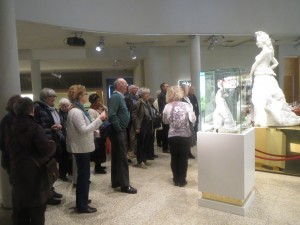 Next day we left for Berlin via Meissen – a delightful town that is home to the famous porcelain factory, which we were able to visit before our lunch-break. There we toured the Meissen museum and watched craftsmen performing some of the intricate modelling and painting processes that put Meissen porcelain in the forefront of the great names in this field. Another Buying Opportunity, then – but most of our party eschewed the four-figure group on offer at €26,545 and searched for a memento among the ‘seconds’. Here we said farewell to our diligent and simpatica guide Susanne, who had made sure we would leave Saxony with a good grasp of regional history; it’s fair to say that any of us who had previously not heard of Augustus the Strong (1674 – 1733) departed for Berlin equipped to make a pretty fair estimate of his inside-leg measurement.
Next day we left for Berlin via Meissen – a delightful town that is home to the famous porcelain factory, which we were able to visit before our lunch-break. There we toured the Meissen museum and watched craftsmen performing some of the intricate modelling and painting processes that put Meissen porcelain in the forefront of the great names in this field. Another Buying Opportunity, then – but most of our party eschewed the four-figure group on offer at €26,545 and searched for a memento among the ‘seconds’. Here we said farewell to our diligent and simpatica guide Susanne, who had made sure we would leave Saxony with a good grasp of regional history; it’s fair to say that any of us who had previously not heard of Augustus the Strong (1674 – 1733) departed for Berlin equipped to make a pretty fair estimate of his inside-leg measurement.
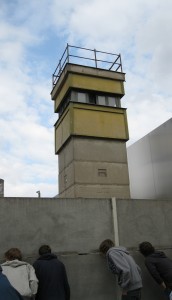 Olaf in Berlin, by contrast, was more of a specialist in current affairs: Frederick the Great he left to the official site-guides, but we quickly learned his views on ‘Empress’ Angela Merkel. A former resident of what had been East Berlin, he gave a description of life behind the infamous Wall, as we moved about the city (we visited sections of the wall kept standing as a memorial, and Checkpoint Charlie), that was both chilling and affecting. In Berlin, as in Dresden, we saw many fine museums and galleries (five in one go on Museum Island) – and more gilt rococo in Charlottenburg Palace
Olaf in Berlin, by contrast, was more of a specialist in current affairs: Frederick the Great he left to the official site-guides, but we quickly learned his views on ‘Empress’ Angela Merkel. A former resident of what had been East Berlin, he gave a description of life behind the infamous Wall, as we moved about the city (we visited sections of the wall kept standing as a memorial, and Checkpoint Charlie), that was both chilling and affecting. In Berlin, as in Dresden, we saw many fine museums and galleries (five in one go on Museum Island) – and more gilt rococo in Charlottenburg Palace 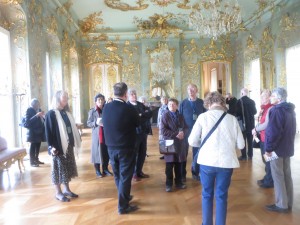 than you could shake a stick at – yet still had energy enough to enjoy a hilarious production of The Magic Flute at the Komische Oper. Tea and cake in Lord Foster’s dome on top of the Reichstag was a highlight, literally, followed by a convivial Farewell Dinner in a restaurant beneath the Friedrichstraße Bahnhof of iconic Cold War fame, where we celebrated (and two hundred students applauded) Jane O’Brien’s birthday.
than you could shake a stick at – yet still had energy enough to enjoy a hilarious production of The Magic Flute at the Komische Oper. Tea and cake in Lord Foster’s dome on top of the Reichstag was a highlight, literally, followed by a convivial Farewell Dinner in a restaurant beneath the Friedrichstraße Bahnhof of iconic Cold War fame, where we celebrated (and two hundred students applauded) Jane O’Brien’s birthday. 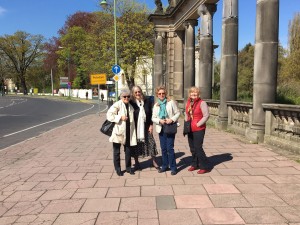 And then it was our last day, and off to Potsdam. Past the Wannsee we were wafted, to the Bridge of Spies, scene of many an exchange of hostages in the Cold War period; then on to Frederick the Great’s austerely rococo Palace of San Souci. After lunch, to Cecilienhof Palace, the English-Tudor-style country house where the Potsdam Conference took place in 1945. How surprising to see Clement Atlee’s signature on the final Accord; Churchill, who had just lost the General Election, declined Attlee’s invitation to attend.
And then it was our last day, and off to Potsdam. Past the Wannsee we were wafted, to the Bridge of Spies, scene of many an exchange of hostages in the Cold War period; then on to Frederick the Great’s austerely rococo Palace of San Souci. After lunch, to Cecilienhof Palace, the English-Tudor-style country house where the Potsdam Conference took place in 1945. How surprising to see Clement Atlee’s signature on the final Accord; Churchill, who had just lost the General Election, declined Attlee’s invitation to attend.
At last the temperature had risen above 7oC – but it was time to return to Tegel Airport, with its purgatory of misdirected queues, unhelpful and peremptory desk-staff, heaving departure-lounges and missed take-off slots.
Enormous admiration and thanks are due to Josephine Willmott, who put the whole scheme together and led her motley (albeit mutually compatible) crew with indomitable courage and good grace. This was not a study visit for the faint-footed, but Josephine’s light touch ensured that it was a resounding success.
Adrian and Norma Williams
Photographs by Mark Phythian-Adams and Adrian Williams
Visit to Hampton Court Palace, March 2016
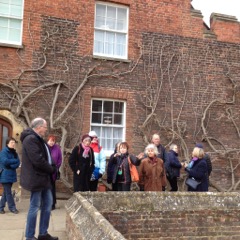 We were taken by coach to Hampton Court Palace on a fine but chilly day. Spring flowers made the Palace grounds particularly beautiful. After coffee we split into two groups for tours of William III’s apartments where, standing under and in the midst of magnificent Antonio Verrio ceilings and murals, we were shown “Abraham” tapestries, Grinling Gibbons carvings and rich furnishings, but learned that William preferred his smaller private rooms. In his private dining room hang portraits of his wife Mary’s friends, the “Hampton Court Beauties” by Knellor. These relatively demure ladies were contrasted with Peter Lely’s “Windsor Beauties” hanging in the Communication Gallery. Representing some of the most important women at the racy court of Charles II, one of these languorous beauties was mother to five of Charles II’s illegitimate children.
We were taken by coach to Hampton Court Palace on a fine but chilly day. Spring flowers made the Palace grounds particularly beautiful. After coffee we split into two groups for tours of William III’s apartments where, standing under and in the midst of magnificent Antonio Verrio ceilings and murals, we were shown “Abraham” tapestries, Grinling Gibbons carvings and rich furnishings, but learned that William preferred his smaller private rooms. In his private dining room hang portraits of his wife Mary’s friends, the “Hampton Court Beauties” by Knellor. These relatively demure ladies were contrasted with Peter Lely’s “Windsor Beauties” hanging in the Communication Gallery. Representing some of the most important women at the racy court of Charles II, one of these languorous beauties was mother to five of Charles II’s illegitimate children.
Another highpoint of the tour was Andrea Mantegna’s “Triumphs of Caesar”, nine huge canvasses painted for the Gonzaga family of Mantua. Making statements about power and success, later world leaders venerated Caesar whilst seeking to emulate his victories. Like much of the Royal Collection, they were acquired by Charles I. To reach the Orangery where they hang we were obliged by building work to take a diversion through the gardens where we could admire the restoration of William III’s Privy Garden of 1702, once again a formal parterre of pyramid yews, round-headed holly and box edging. It was reopened in 1995.
Finally, our two excellent guides took us to the Cartoon Gallery, built to display Raphael’s cartoons for the great tapestry series, “The Acts of the Apostles”, commissioned for the Sistine Chapel in Rome. Bought by Charles I, the original cartoons remain, sadly for Hampton Court Palace, on loan to the Victoria & Albert Museum.
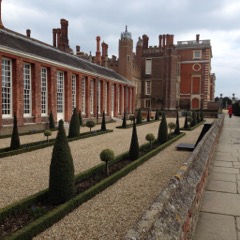 After a sandwich lunch there was free time to explore the rest of the Palace. The Cumberland Art Gallery, taking up four rooms of the apartment of William, Duke of Cumberland, designed by William Kent, was unmissable. It currently houses a room of small Canalettos and a diverse collection of portraits, landscapes and allegorical scenes. Self-portraits by Rembrandt and Artemisia Gentileschi are among the highlights. There was also the opportunity to visit the Tudor Great Hall, where most of the “Abraham” tapestries hang, and the Chapel Royal, with its magnificent Tudor ceilings and a large oak reredos carved by Grinling Gibbons for Queen Anne.
After a sandwich lunch there was free time to explore the rest of the Palace. The Cumberland Art Gallery, taking up four rooms of the apartment of William, Duke of Cumberland, designed by William Kent, was unmissable. It currently houses a room of small Canalettos and a diverse collection of portraits, landscapes and allegorical scenes. Self-portraits by Rembrandt and Artemisia Gentileschi are among the highlights. There was also the opportunity to visit the Tudor Great Hall, where most of the “Abraham” tapestries hang, and the Chapel Royal, with its magnificent Tudor ceilings and a large oak reredos carved by Grinling Gibbons for Queen Anne.
There is no shortage of tea-rooms at Hampton Court, something most of us took advantage of before the drive home. The day had served as a taster for the delights of the Palace, which has much more to offer for another day.
Visit to Sandham Memorial Chapel, Burghclere and the Stanley Spencer Gallery in Cookham, May 2016
For those who did not know the work of Stanley Spencer, this visit was the perfect introduction; for those who did, a wonderful opportunity to revisit some of his oeuvre.
The combination of the two venues was a brilliant idea. Sandham Memorial Chapel offered us a glimpse into Spencer’s wartime experiences as a medical orderly in Bristol’s Beaufort War Hospital and as an infantryman at the Macedonian front, and their subsequent transformation into an extraordinary work of art. The exhibition at Cookham, entitled Stanley Spencer: Visionary Painter of the Natural World, provided a fascinating contrast, revealing Spencer’s consummate skill as a painter of flowers, garden vistas and portraits.
We were fortunate to have highly knowledgeable and enthusiastic guides at both venues, whose insights contributed greatly to our appreciation of Spencer’s work.
Our thanks go to Judith Bentley for arranging such an illuminating and enjoyable visit.
Josephine Willmott
The Queen’s Chapel of The Savoy and Two Temple Place, Feb 2016
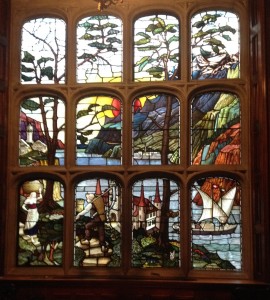 We spent an informative and highly enjoyable day visiting the Queen’s Chapel of the Savoy and nearby Two Temple Place. A couple of interesting talks introduced us both to the history of the Chapel, formerly part of a hospice founded by Henry VII, and to its current importance as the Chapel of the Royal Victorian Order, founded in 1896 to recognise distinguished personal service to the monarch. The stained glass windows, including one marking the Queen’s Diamond Jubilee, were fascinating.
We spent an informative and highly enjoyable day visiting the Queen’s Chapel of the Savoy and nearby Two Temple Place. A couple of interesting talks introduced us both to the history of the Chapel, formerly part of a hospice founded by Henry VII, and to its current importance as the Chapel of the Royal Victorian Order, founded in 1896 to recognise distinguished personal service to the monarch. The stained glass windows, including one marking the Queen’s Diamond Jubilee, were fascinating.
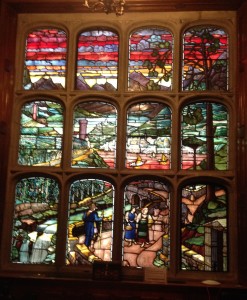
The afternoon was devoted to exploring the stunning mansion built for the wealthy American, William Wardorf Astor, to serve primarily as his London office. A guided tour introduced us to Astor’s cultural tastes and literary interests exhibited on staircase carvings, wall paintings, wood panelling, stained glass windows and marble flooring. We also had the chance to visit the fifth winter exhibition put on by the Bulldog Trust to showcase publicly owned art from regional collections in the UK, Beyond Beauty, which offered a fascinating insight into the importance of appearance in the afterlife for the ancient Egyptians.
Warm thanks go to Kathryn Hopkins for once again devising and organising such an unusual and fascinating visit.
Judith Bentley and Josephine Willmott
A visit to The Wallace Collection, November 2015
20 members made their way to London and met up at Hertford House for a highlight tour of the Wallace Collection. Our excellent guide lead us up to the 1st floor landing and, with a rather distracting background of very large Boucher paintings of frolicking maidens, she gave us a brief history of the Hertford family. Although some of the works of art were acquired in the 18th century it was in the 19th century, post the French Revolution, when the 3rd Marquess followed by his son, the 4th Marquess who had been brought up in Paris, became seriously interested in expanding the art collection.
Our guide took us through each room pointing out particular items of interest which we could return to later in the day. There were portraits by Reynolds, Gainsborough and Thomas Lawrence; French furniture by Boulle inlaid with turtleshell and brass or different types of wood; Italian majolica; two German nobleman mounted on horseback and equipped with complete sets of armour for both horse and rider; several of Watteau’s fêtes galantes and Fragonard’s The Swing; Sèvres porcelain from the Empress Catherine II of Russia’s collection; exquisite miniature paintings and gold boxes; a gallery of Canalettos and Guardis; and followed by another gallery with Rembrandt’s Portrait of his son Titus, Pieter de Hooch’s A Boy Bringing Bread and Jan Steen’s Celebrating the Birth where he portrays himself making the cuckold’s sign over the father’s head.
In the Great Gallery, purpose built with natural light from the glazed ceiling, we viewed Pousin’s A Dance to the Music of Time (the inspiration for Anthony Powell’s title for his series of novels), Titian, Rubens, Velázquez, Frans Hals (The Laughing Cavalier), van Dyck and many more.
Finally, as a contrast to the art, we came upon highly decorated flint-lock pistols made for Louis XIV and Tsar Nicholas I plus many more firearms and swords in the Armoury Gallery.
Then we went for a well-earned lunch in the beautiful glazed courtyard and compared notes on what particularly caught our eye. Afterwards we were free to wander around and remind ourselves of what an amazing feast the Wallace Collection is.
Get to know ….. Ceramics Handling with Dinah Reynolds, March 2016
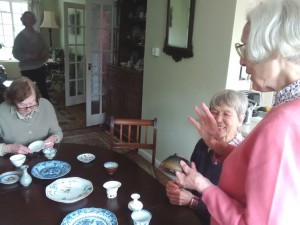 ‘Brilliant’, ‘Wonderful’, ‘Absolutely fascinating’, ‘The collection is superb’
‘Brilliant’, ‘Wonderful’, ‘Absolutely fascinating’, ‘The collection is superb’
– these were a few of the comments made by the participants.
Forty years ago when Dinah Reynolds answered a request for ‘two ladies’ to volunteer in the Ceramics section of the Western Arts Department at the Ashmolean, little did she know that she was about to embark upon a passion which lasts to this day. Dinah says that apart from the names of a few factories, Wedgwood, Worcester, etc., she knew nothing about ceramics. As was obvious to all those of us who were lucky enough to attend the latest Get to Know… session, Dinah is now an expert who has even written a book on the subject and who has lectured all over the world to NADFAS groups.
With immense knowledge and enthusiasm, Dinah guided us through the development of porcelain from the early days in China’s Song dynasty through Japanese ware to German, French and, finally, English pieces.
Dinah had commented that it is impossible to understand porcelain properly without handling the pieces. As she passed around the different objects, we began to see what she meant as we felt the weight, the texture, the smoothness of the surface, felt the imperfections, skilfully disguised under the decoration.
One of my favourite pieces was a ‘trembleuse’ – a saucer with a projecting central ring in which the cup was placed to prevent it from slipping around should the drinker’s hand shake. I was also intrigued by the sharpness and clarity of saltglaze stoneware, which is achieved by throwing salt into the kiln. The very fine coating ensures the incised decoration loses none of its definition.
I can only echo another comment – ‘My eyes have been opened. Never again will I walk past the Ceramics Section of a museum with just a quick glance!’
Many, many thanks to Dinah.
Get to know ….. Constable and Turner Paintings with Pat Dugdale, January 2016
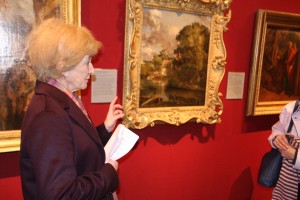 Oxford DFAS is one of, if not the, fastest-growing society in the country. Now operating a morning and afternoon lecture for each meeting, the society has embarked on a series of ‘Get to Know’ events in which a member gives a talk, discussion or visit in Oxford.
Oxford DFAS is one of, if not the, fastest-growing society in the country. Now operating a morning and afternoon lecture for each meeting, the society has embarked on a series of ‘Get to Know’ events in which a member gives a talk, discussion or visit in Oxford.
The pre-Christmas talk on Coffee was greatly oversubscribed and the latest ‘Get to Know’, a talk on the paintings of Turner and Constable, was so popular that Pat Dugdale, immediate Past Chairman, organised four sessions but was still unable to meet all the demand.
This event, designed to enable members to get to know one another, was held at Oxford’s Ashmolean Museum. Paintings discussed included Turner’s Oxford High Street in 1810 and Constable’s Willy Lott’s House.
The photo shows Pat discussing out some of the finer points of the painting of Willy Lott’s House.
Walking Tour of Medieval Oxford, with Alastair Lack, December 2015
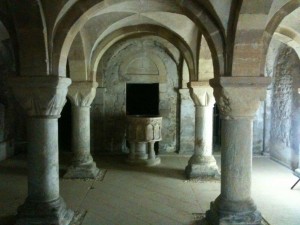 On a cold but mostly sunny day, we had a very informative tour of 3 medieval sites in Oxford. We started by visiting the crypt of St Peter’s which is rarely open for visitors, a very atmospheric space used in medieval times to store relics. We moved on to New College where we learned some fascinating history, including the inspection by the Lord Mayor of the city walls which takes place every 3 years. We visited the chapel and saw the wonderful Medieval windows, and we also visited the hall. Finally we went to the fifteenth century Divinity School in the Bodleian, a masterpiece of Gothic architecture.
On a cold but mostly sunny day, we had a very informative tour of 3 medieval sites in Oxford. We started by visiting the crypt of St Peter’s which is rarely open for visitors, a very atmospheric space used in medieval times to store relics. We moved on to New College where we learned some fascinating history, including the inspection by the Lord Mayor of the city walls which takes place every 3 years. We visited the chapel and saw the wonderful Medieval windows, and we also visited the hall. Finally we went to the fifteenth century Divinity School in the Bodleian, a masterpiece of Gothic architecture.
Very many thanks to Alastair Lack for an erudite and entertaining tour, and to Wendy Castle for organising it, and the one that took place the week before.
Visit to Nepal and Bhutan, October 2015
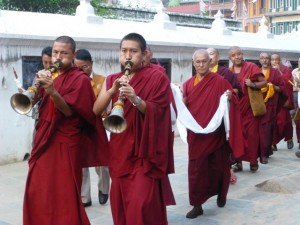 In mid-October 2015, 13 members and guests of OXDFAS visited Nepal and Bhutan. Zara Fleming (who has lectured to OXDFAS) was an inspiring and entertaining expert leader. Our grateful thanks go to Josephine Willmott for setting up the trip. Before October few of us knew much about Bhutan, a Himalayan kingdom occupying roughly the area of Switzerland, with a population of only 780,000. Serfdom was only abolished and land reform introduced in the 1950’s. It is now a modern constitutional democracy with a controlled approach to development and an Oxford educated king. The people have a strong sense of national identity, apparent in the daily wearing of national dress, and in the adherence to a strikingly attractive traditional building style: even the airport buildings and the kiosk occupied by the policeman directing the traffic in the capital, Thimphu, conform!
In mid-October 2015, 13 members and guests of OXDFAS visited Nepal and Bhutan. Zara Fleming (who has lectured to OXDFAS) was an inspiring and entertaining expert leader. Our grateful thanks go to Josephine Willmott for setting up the trip. Before October few of us knew much about Bhutan, a Himalayan kingdom occupying roughly the area of Switzerland, with a population of only 780,000. Serfdom was only abolished and land reform introduced in the 1950’s. It is now a modern constitutional democracy with a controlled approach to development and an Oxford educated king. The people have a strong sense of national identity, apparent in the daily wearing of national dress, and in the adherence to a strikingly attractive traditional building style: even the airport buildings and the kiosk occupied by the policeman directing the traffic in the capital, Thimphu, conform!
Our itinerary in Bhutan took us through beautiful mountainous countryside from Paro in the west, eventually to the Bumthang valley area in the centre of the country, 300 km to the east. Only one road traverses Bhutan from west to east. Much of it is a huge, rough, linear construction site and appears likely to remain so for years to come, a situation not unfamiliar to residents of Oxfordshire!
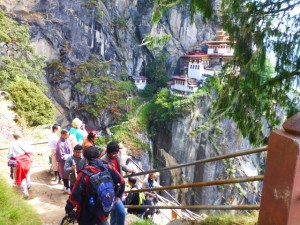 Buddhism came to Bhutan in the Eighth Century, thanks to the missionary work of the celebrated Guru Rimpoche. We were to see many images of him in the beautiful artistry of temples and monasteries in his eight different guises, some distinctly fearsome! He is said to have meditated in a cave high up in an almost vertical cliff, carried there by a consort who took the form of a flying tiger for the purpose. Thus the place became Taktshang or the ‘Tiger’s Nest’ and a sanctuary was eventually built there in the Fourteenth Century. Today, the Tiger’s Nest is perhaps the most celebrated image of Bhutan. The trail of three and a half miles each way rises almost 3,000 feet from the valley floor to the sanctuary at a height of 9,680 feet: a truly memorable experience! Most of the members of the party managed to get all the way up the steep and rough track. Many temples were built at the top of steep hills which made us appreciate the toughness of the local population. Some of us ended the trip a little fitter than we had been at the start!
Buddhism came to Bhutan in the Eighth Century, thanks to the missionary work of the celebrated Guru Rimpoche. We were to see many images of him in the beautiful artistry of temples and monasteries in his eight different guises, some distinctly fearsome! He is said to have meditated in a cave high up in an almost vertical cliff, carried there by a consort who took the form of a flying tiger for the purpose. Thus the place became Taktshang or the ‘Tiger’s Nest’ and a sanctuary was eventually built there in the Fourteenth Century. Today, the Tiger’s Nest is perhaps the most celebrated image of Bhutan. The trail of three and a half miles each way rises almost 3,000 feet from the valley floor to the sanctuary at a height of 9,680 feet: a truly memorable experience! Most of the members of the party managed to get all the way up the steep and rough track. Many temples were built at the top of steep hills which made us appreciate the toughness of the local population. Some of us ended the trip a little fitter than we had been at the start!
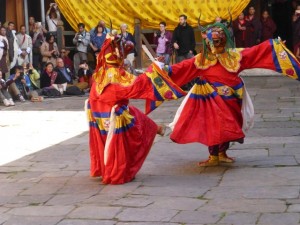 Historically, each region of Bhutan was governed from a strategically situated power base, known as a Dzong. These strikingly beautiful buildings, each combining fortress, temple, royal apartments and government offices, were to be another set of top attractions in our programme. Our visit to the Dzong at Jakar was timed to coincide with a three day “tsechu”, or religious festival. Elaborate dances are performed by monks in exotic dresses to the sound of cymbals and string instruments. Other monks, dressed as jesters in red masks and costumes, take part in the dances and provide the crowd with light relief.
Historically, each region of Bhutan was governed from a strategically situated power base, known as a Dzong. These strikingly beautiful buildings, each combining fortress, temple, royal apartments and government offices, were to be another set of top attractions in our programme. Our visit to the Dzong at Jakar was timed to coincide with a three day “tsechu”, or religious festival. Elaborate dances are performed by monks in exotic dresses to the sound of cymbals and string instruments. Other monks, dressed as jesters in red masks and costumes, take part in the dances and provide the crowd with light relief.
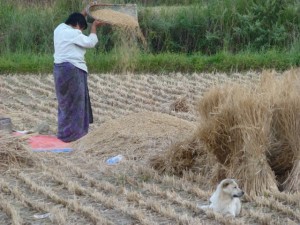 We will treasure many other images of Bhutan: the interesting local people we met, the monks, the prayer wheels and flags, and the scenes of villagers manually working the rice paddies. These contrasted with some striking modern images such as the smart phones being used by many of the monks.
We will treasure many other images of Bhutan: the interesting local people we met, the monks, the prayer wheels and flags, and the scenes of villagers manually working the rice paddies. These contrasted with some striking modern images such as the smart phones being used by many of the monks.
We travelled to and from Bhutan via Nepal and stopped briefly there. Kathmandu was less damaged by the earthquake than we had expected, although some heritage buildings had suffered. Despite the trials of a typically large polluted Asian city, we enjoyed visiting the historic centre and the significant number of buildings that have survived.
Margaret and Clive Booth
Get to know ….. Coffee – one of the oldest drinks in the world, October 2015
Coffee is clearly not a 19th century discovery made by the Americans as many people believe – it is in fact one of the world’s oldest drinks as our Oxford DFAS members found out.
57 Members of both our morning and new afternoon group enjoyed an extremely well-researched talk by Member Muriel Passey, on the history of coffee and the great influence it has had on making the ’coffee shop’ the business and social centres they are today.
This meeting, one of our society’s very popular ‘Get to Know…’ events, was designed for members new (there are a lot of them) and old, to get to know one another at an informal event.
The Old Library (the first university library) above the Vaults Cafe of St Mary’s Church, Oxford, was packed to maximum capacity for this occasion that started with the opportunity to taste coffee from Guatamala.
Coffee was first recorded in Ethiopia in AD 1000 and in 1607 an English trader tasted it for the first time. The Pope later baptised coffee in Italy, one of the first countries to adopt this new drink (did he achieve this by adding a little holy water)?
The first UK coffee house was The Angel in Oxford which opened in 1650. The popularity of coffee shops was due to a combination of factors ranging from the promises that the shops attributed to the drink, which ranged across most health and medical areas, coupled with them providing a place to read the papers or pick up the latest business and domestic gossip. In time much business was carried out in these places as they became what we today call ‘networking opportunities’.
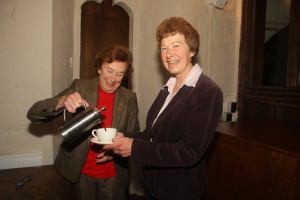 The thirst cup is the greatest – OXDFAS committee member and organiser of the talk, Alison Porter, receives her first cup of the day from speaker and Society Member Muriel Passey (left).
The thirst cup is the greatest – OXDFAS committee member and organiser of the talk, Alison Porter, receives her first cup of the day from speaker and Society Member Muriel Passey (left).
Inaugural AGM of the newly enlarged Oxford DFAS
September 22nd 2015 heralded a milestone in the history of Oxford DFAS. It was the day of the first AGM for the newly doubled membership of Oxford DFAS. Since the committee took the decision in January 2015 to enlarge the Society and to hold two lecture sessions on the same day, a great deal of work had been undertaken particularly by Colin Redman, membership secretary, but also by all members of the committee in their particular areas of responsibility, to reach this point. And so, on September 22nd 2015, we welcomed both morning and afternoon session members to the AGM.
To accommodate the larger numbers and to enable the whole Society to meet together in one group under one roof it was a great delight to be able to hold the AGM in the splendid and contemporary style of the new Mathematical Faculty auditorium of the Andrew Wiles building in the Radcliffe Observatory Quarter. Financial support to enable this came from a grant issued to us by NADFAS House. The AGM provided the opportunity for new members to meet continuing ones and to identify committee members. After a welcoming tea or coffee, the meeting went off smoothly with the new committee being voted in for 2015/2016. We sadly said farewell to Polly Woolstone, chair of the Visits group who did so much to launch our extensive Visits programme from scratch, but were grateful to Kathryn Hopkins (deputy chair) for agreeing to represent the Visits group at committee meetings.
The AGM was followed by an excellent lecture by Anthony Russell on Holbein’s Ambassadors which took us right into the painting and illuminated many of us on the true significance of the symbolism contained in the work. With much to think and talk about, everybody present enjoyed the chance to mingle at the drinks reception held outside in the public area of the building.
This event was a wonderful way to start the new structure of our Society and we all look forward to the coming year with renewed interest and optimism.
Kate Lack, Chairman, Oxford DFAS
